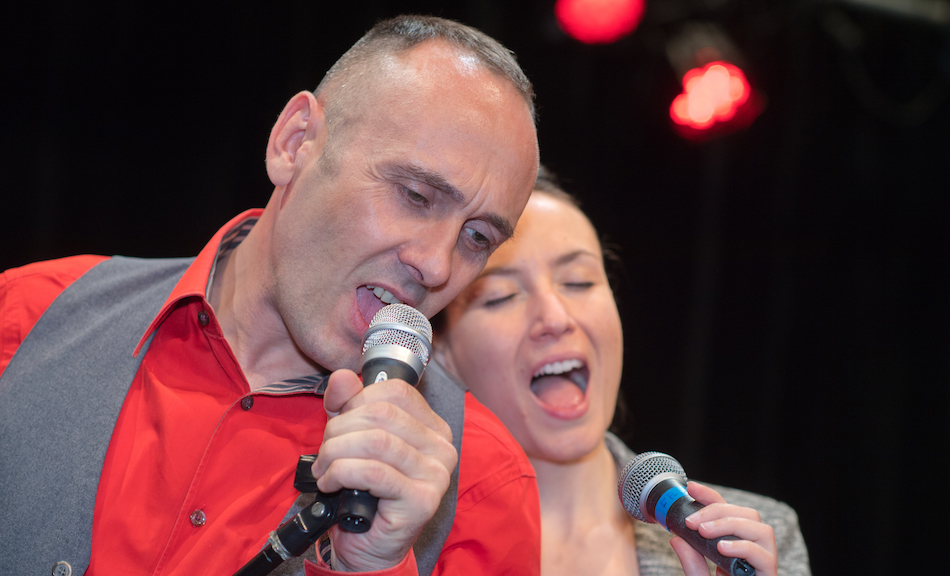
The first time I saw a musical improv performance, I fell in love. The improv duet is a particularly important form in an improvised musical – necessary to explore relationships in the narrative and requiring group mind and excellent agreement between the two performers. But it can be hard to find info on how to perform a good musical improv duet, especially if you live in a city without a full, 5- or 6-level musical improv training program.
In an improvised musical, duets serve to explore the relationship between two characters who typically have a love or hate relationship (protagonist-antagonist, parent-child, two lovers). Musical improv duets are powered by strong emotions and tend to focus on the characters’ relationship.
Below, I’ll discuss some common song structures for improvised duets, as well as who should sing them and why a duet makes sense in an improvised musical. Once you know how a duet fits into the overarching structure of a musical, you’ll be able to integrate them more naturally into your musical improv performances.
The Purpose of Musical Improv Duets
Before we jump into the mechanics of how to structure a musical improv duet, it’s worth asking : why would you sing one? What purpose do they serve in the grand scheme of a musical?
The answer (according to lots of real-life musicals): Improvised duets are emotion-driven songs about exploring relationships.
This fact informs both who sings a duet and what duets are about (i.e., their place in the musical).
Who Sings a Duet?
Think about famous duets from well-known musicals. What do the people singing these duets have in common?
- “All I Ask of You” from The Phantom of the Opera: The Phantom and Christine
- “Popular” from Wicked: Elphaba and Galinda
- “A Heart Full of Love” from Les Misérables: Marius and Cosette (and, technically, Eponine)
- “16 Going on 17” from The Sound of Music: Liesl and Rolf
- “Take Me or Leave Me” from RENT: Maureen and Joanne
- “I Don’t Need Anything But You” from Annie: Annie and Daddy Warbucks
All of these musical duets feature two people who have a strong love or hate relationship with each other. The majority of musical duets are romantic songs, and those that aren’t romantic often feature close friends of family members. That is, people who feel deeply about each other.
Here are common relationships you might find in a musical improv duet:
- Protagonist and their love interest
- Protagonist and best friend/sidekick
- Parent and child
- Protagonist and antagonist
Why Sing a Duet? What Is a Duet Really about?
Generally speaking, solos are about what a character wants, a driving desire or goal. Group numbers are often about an action that’s taking place, a setting or more general circumstance, or a glimpse at a group of characters.
Duets, however, are about a relationship and emotion.
Think about the musical theatre duets above: sometimes the two singers are in conflict, and sometimes they are in agreement. Sometimes one is persuading the other. But in each case, the conflict or agreement revolves around their interpersonal relationsip and is driven by a strong emotion.
When you’re improvising a duet, focus on taking the emotion(s) from your scene and amplifying them. Musicals, by nature, amplify and exaggerate the emotion of everyday life. That’s part of what makes them so powerful.
Don’t worry about trying to fit a lot of plot into your song. Improvised songs go by very quickly, and deepening an interpersonal conflict and/or exploring a relationship are enough to handle in one song as it is.
Common Improvised Duet Structures
Improvised singing is hard. It’s really, really hard. But singing with a partner requires a whole new level of agreement. For that reason, it can be really helpful to have a shared understanding of some common improv duet song structures. While you can always deviate from these structures, these are common forms that will sound “like a real song” to your audience.
Verse-Chorus Song Structure
This is the song structure that we’re probably most familiar with: it’s in lots of pop songs and Top 40 hits, as well as a number of musicals. You have a series of verses (with similar structure, rhyme scheme, and melody) with a repeated chorus in between.
In a duet, this verse-chorus song structure might look something like this:
Chorus x2 Verse 1 Chorus x2 Verse 2 Chorus x2
Many “real” songs begin with a verse, then flow into the chorus, but in an improvised musical, you need to make sure you’re on the same page as your duet partner. Starting with one improviser singing the chorus (and the other repeating the chorus with them a second time) helps solidify the chorus in both people’s minds.
This is important because:
- It establishes what the song is about quickly
- After someone signs verse 1, both people can confidently sing the chorus in unison, giving the appearance of a “real” or pre-rehearsed song.
Tips for the verse-chorus song structure:
- Make your chorus SIMPLE. Especially in a duet. Remember that the other player has to remember both the words and the melody of your chorus after hearing it only once.
- Your verses should be of equal length and match each other. If player 1 sings a 4-line verse, player 2 should sing a 4-line verse.
- End with a big finish. You’re ending on the chorus, which you both have sung several times now, so sing confidently and end big.
Tagline Song Structure
Very common in musical theatre, another often-used duet song structure is the tagline song. In a tagline song, the role of the chorus is eliminated and replaced by one repeating line, usually either the first or the last line of each verse.
You can see this in the song “Part of Your World” from The Little Mermaid. Ariel doesn’t sing a full chorus in this song; instead, she repeats one line (“…part of your world”) over and over again. It’s this tagline that ties the song together and gives it structure.
The tagline can either be the first line of each verse, or it can be the last line of each verse. Once the tagline is established, keep its place consistent throughout. The one exception is the bridge, which is often a deviation from the melody or perspective of the other verses.
Here’s the basic structure of a tagline song with the tagline at the end of each verse.
Verse 1: Line 1 Line 2 Line 3 Tagline Verse 2: Line 1 Line 2 Line 3 Tagline Bridge (no tagline): Line 1 Line 2 Line 3 Line 4 Verse 4: Line 1 Line 2 Line 3 Tagline
And here’s a real first-line tagline song in action: In “Sixteen Going on Seventeen” from The Sound of Music, the tagline “You are/I am sixteen going on seventeen” is repeated at the beginning of every verse – except for the bridge (“Totally unprepared are you…”).
The Fugue (aka “Tagline Duet”)
If you haven’t heard of a fugue before, just think of the song “Fugue for Tinhorns” from Guys and Dolls. There is a technical musical composition definition for a fugue, and my definition is grossly oversimplifying. However, in the context of musical theatre (and musical improv), a fugue is essentially a song where characters are singing different verses at the same time.
Think the song “The Confrontation” from Les Miserables, where Jean Valjean and Ja Ver both sing their separate verses on top of each other. If this sounds like it would be difficult to improvise , you’re right. But when it works, it’s awesome.
One way to approahc a figure as a musical improviser is to use a form called the Tagline Duet. Here’s how it goes:
Verse 1 (sung by improviser 1): Line 1 Line 2 Line 3 Tagline Verse 2 (sung by improviser 2): Line 1 Line 2 Line 3 Tagline Bridge (sung by both improvisers): This could be structured in a number of ways: with each improviser alternating lines, with one talking lines 1 and 2 and the other lines 3 and 4, with a dance break, etc. Verse 3 (sung togeher): Both improvisers repeat their respective verses at the same time. They should match their lines and tempo so that they sing the final tagline in unison.
As with any tagline song, the tagline can be the first or last line in the verse through I think it’s especailly powerful to end this type of song singing the tagline together.
Tagline duet tips:
- Make it clear that you think you’re singing a tagline song. Make eye contact and give the line you hope to be the tagline special emphasis. Then hope your fellow improviser picks up on it in their verse.
- Make the tagline SIMPLE. You’ve got enough going on in this song without adding a complicated tagline to the mix.
- Incorporate actions/motions into your first verse to help you remember. As simple as it sounds, making a motion like a sunrise while you’re singing about a sunrise can really help you remember your lyrics when you get to the fugue section in verse 3.
- Don’t worry about getting every word right in verse 3. Can’t remember exactly what you sang in verse 1? Neither can the audience. The most important thing is to keep singing and be confident. Try to get as close as you can to your original verse, but if you own what you’re singing, the audience might not even notice small mistakes.
Duet or Solo: How to Choose
So, you’re playing the protagonist in an improvised musical. You know some structure options, you’re onstage with your love interest, and it’s clear that a song is coming on soon. How do you know if it’s time to sing a duet or a solo?
There are two factors I (personally) use to decide:
- Where are we in the musical as a whole?
- What is the scene leading into the song about?
Where you are in the musical is important. Have you already had a duet recently? Have you explored this relationship enough given the time that you have?
But the biggest factor is the scene leading into that song. The Musical Improv Notes blog gives great advice: Look at what each character wants.
Whoever has the stronger want in general gets the song. If you both share the same strong want, then you can share the verses and sing the choruses or taglines together. If you have opposing views of the want, the person who has a more negative view usually will take the bridge. Ultimately, it’s discovered in the moment.
Musical Improv Notes, “Duets and Solo Songs”
If the protagonist has expressed a strong want or desire leading into the song, it’s probably a solo. If the conversation leading up to the song is about the two characters and their relationship to each other (or you both have the same or equally strong wants) it might be a duet.
